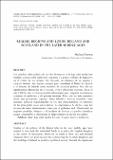Files in this item
Realms, regions and lords : Ireland and Scotland in the later middle ages
Item metadata
| dc.contributor.author | Brown, Michael Hunter | |
| dc.date.accessioned | 2018-01-19T10:30:28Z | |
| dc.date.available | 2018-01-19T10:30:28Z | |
| dc.date.issued | 2015 | |
| dc.identifier | 252009078 | |
| dc.identifier | db11d6e9-ad9c-4753-846b-3a48f57575f6 | |
| dc.identifier.citation | Brown , M H 2015 , ' Realms, regions and lords : Ireland and Scotland in the later middle ages ' , Anales de la Universidad de Alicante. Historia Medieval , vol. 19 , pp. 153-174 . https://doi.org/10.14198/medieval.2015-2016.19.05 | en |
| dc.identifier.issn | 0212-2480 | |
| dc.identifier.uri | https://hdl.handle.net/10023/12517 | |
| dc.description.abstract | Los estudios sobre política de las Islas Británicas en la baja edad media han tendido a tratar sobre territorios concretos o a poner el Reino de Inglaterra en el centro de los debates. No obstante, en términos de su tamaño y carácter interno, hay buenas razones para considerar el Reino de Escocia y el Señorío de Irlanda como modelos de sociedad política. Más allá las significativas diferencias en el estatus, leyes y relaciones externas, hacia el año 1400 los dos territorios pueden relacionarse por compartir experiencias comunes de gobierno y de guerras internas. Éstas son las más aparentes desde una perspectiva regional. Tanto Irlanda y Escocia operaban como sistemas políticos regionalizados en los que predominaban los intereses de las principales casas aristocráticas. La importancia de dichas casas fue reconocida tanto internamente como por el gobierno real. Observando en regiones paralelas, Munster y el nordeste de Escocia, es posible identificar rasgos comparables y diferencias de largo término en dichas sociedades. | Studies of the polities of the British Isles in the later middle ages have tended to deal with the individual lands or to place the English kingdom at the centre of discussions. However, in terms of their size and internal character there are good reasons for considering the Scottish kingdom and the lordship of Ireland as models of political society. Beneath the significant differences of status, law and external relationships, around 1400 the two lands can be regarded as sharing common experiences of government and internal warfare. These are most apparent from a regional perspective. Both Ireland and Scotland operated as regionalised polities in which the interests of major aristocratic houses predominated. The importance of such houses was recognised both internally and by the royal government. By looking at parallel regions, Munster and north-east Scotland, it is possible to identify comparable features and long-term differences between these societies. | |
| dc.format.extent | 22 | |
| dc.format.extent | 348157 | |
| dc.language.iso | eng | |
| dc.relation.ispartof | Anales de la Universidad de Alicante. Historia Medieval | en |
| dc.subject | Baja Edad Media | en |
| dc.subject | Escocia | en |
| dc.subject | Guerra | en |
| dc.subject | Gobierno | en |
| dc.subject | Late Medieval | en |
| dc.subject | Scotland | en |
| dc.subject | Ireland | en |
| dc.subject | War | en |
| dc.subject | Government | en |
| dc.subject | D111 Medieval History | en |
| dc.subject | DA Great Britain | en |
| dc.subject | BDQ | en |
| dc.subject.lcc | D111 | en |
| dc.subject.lcc | DA | en |
| dc.title | Realms, regions and lords : Ireland and Scotland in the later middle ages | en |
| dc.type | Journal article | en |
| dc.contributor.institution | University of St Andrews. School of History | en |
| dc.contributor.institution | University of St Andrews. St Andrews Institute of Medieval Studies | en |
| dc.identifier.doi | 10.14198/medieval.2015-2016.19.05 | |
| dc.description.status | Peer reviewed | en |
This item appears in the following Collection(s)
Items in the St Andrews Research Repository are protected by copyright, with all rights reserved, unless otherwise indicated.

